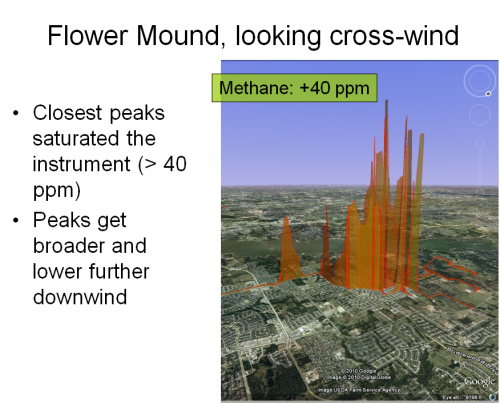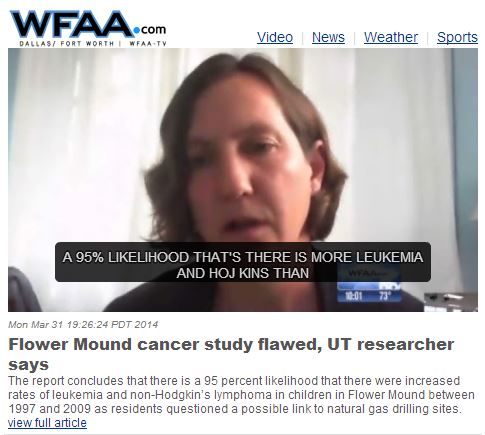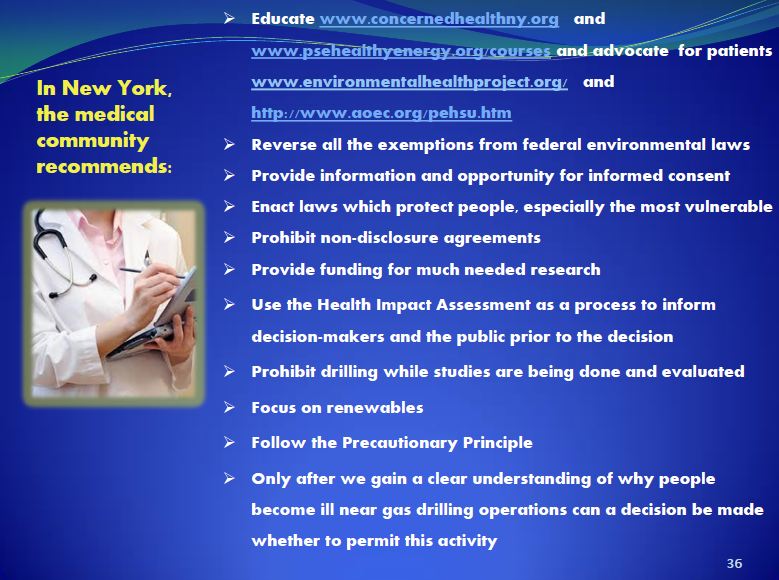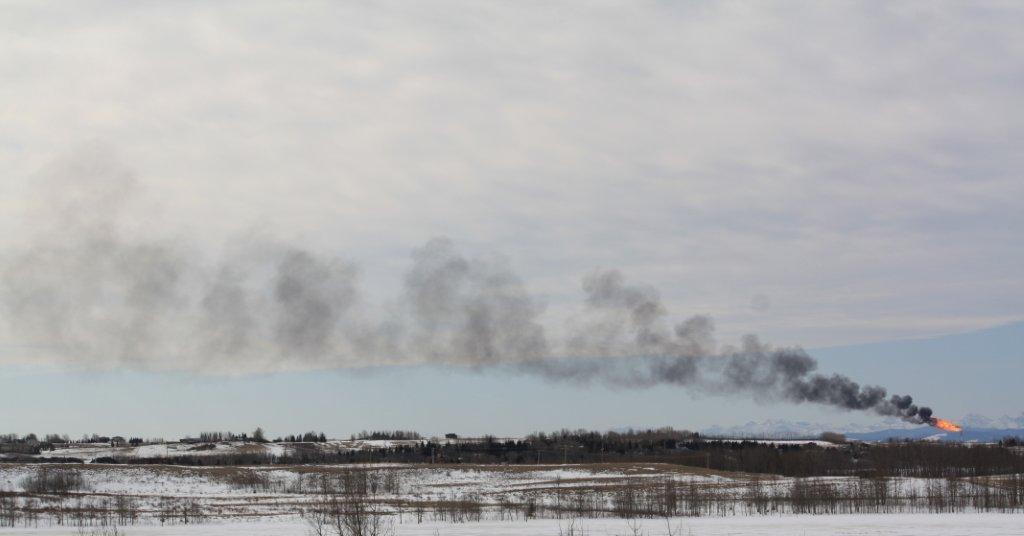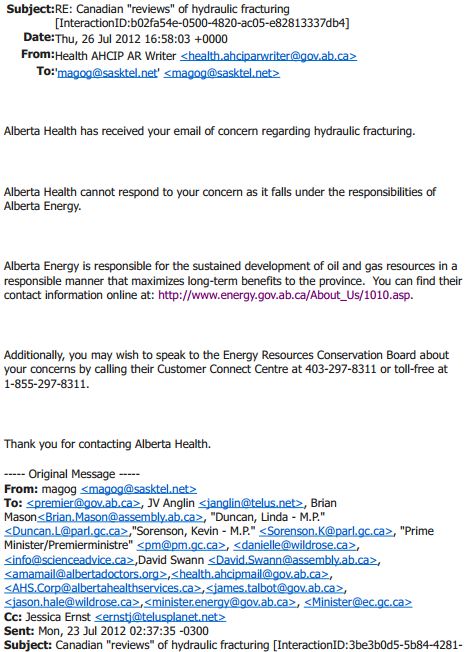A Barnett Shale Manifesto…From Austin by Jim, March 31, 2014, downwindersatrisk.org
Sometimes it takes a perspective above the grind of trench warfare to give you a better sense of what the entire battlefield looks like. …
Don’t let the academic title fool you. This is a call for a radically new approach to how communities in Texas regulate the risks of fracking, and every other type of heavy industry. We put the link up for the piece on our Facebook page on Saturday based on a quick reading of its commentary on the Flower Mound cancer cluster, but it’s more, so much more than that. Among other things, it’s a comprehensive rebuttal of every claim of safety and well-being ever issued by the industry or state authorities about the health of residents living in the Barnett Shale, of which the Flower Mound case is only one example. Rawlins has produced a one-stop catalog of each major air pollution health controversy in the Barnett since concerns began to grow in the last decade, with an almost 30-page review of why no industry or government-sponsored study of fracking pollution and its health effects is a satisfactory response to those concerns. Want to convince your local officials that fracking isn’t as safe as it’s touted? Here’s the staggering blow-by-blow commentary to do it.
But all of that documentation is presented in service to making the point that current state and federal regulation of fracking is failing to protect public health, both in design and in practice. Professor Rawlins’ solution to this problem is not to give the state and federal government more power to regulate the gas industry. No, it’s to turn the current regulatory framework upside down and give more power to local governments to do the things that the state and federal government should be doing.
In making this recommendation, she echoes the strategy that’s been driving Downwinders since it was founded – that the best way to regulate pollution problems is at the local level where the most harm is being done, and it should be directed by the people being harmed. … This strategy avoids battles where industry is strongest – in the halls of the state capitol and in DC, where citizens are outspent millions to one. Instead, it takes the fight to neighborhoods where the harm is being done or proposed, where people have the most to lose, where the heat that can be applied to elected officials is more intense. Citizens will still get outspent, but the money doesn’t seem to buy corporations as much influence among those actually breathing the fumes of the drilling site, or smokestack. [Emphasis added]
OMG! I am so shocked (not) that Texas lied about the cancer cluster! by TXSHARON, April 1, 2014, Blue Daze
Um, hell yeah the state lied. … But let’s get real here:
Who thinks you can breathe hydrocarbons and not get sick?
CoughingThroughTears April 2, 2014 at 8:47 am:
I would show this to my husband, but he died of secondary leukemia, two years after drilling came to our back yard.
Flower Mound cancer study flawed, UT researcher says by WFAA, March 31, 2014
FLOWER MOUND — Families with children who are battling cancer may be searching for even more answers after reading a just-published study from a researcher at the University of Texas at Austin. Authored by Rachael Rawlins, the report concludes that there is a 95 percent likelihood that there were increased rates of leukemia and non-Hodgkin’s lymphoma in children in Flower Mound between 1997 and 2009.
The finding was only one in a larger conclusion that effectively said the state needs to revamp how it conducts public health studies. “That really is important,” said Rawlins in a Skype interview with News 8. “We should think about looking carefully at toxic emissions in relation to effects.”
In 2010, News 8 profiled a number of Flower Mound families who had children suffering from cancer. Some were adamant that fracking operations in the area were at least partly to blame. “You see the families at the clinic, and the similarities. They either lived by a drilling facility, or have it in their backyard,” said Sheri Schmidt in a 2010 interview. Of particular concern was the emission of benzene.
The city convinced state health officials to conduct a study, but the state’s analysis found the number of cancer cases among kids was not higher than in other parts of Texas. [Sounds Like Alberta Health Services Fort Chipewyan Tarsands Cancer Study]
Rawlins now says that finding was flawed. “They used a 99 percent confidence interval,” she said. “Scientific convention generally defines statistical significance using the 95 percent confidence interval.” [Emphasis added]
PLANNING FOR FRACKING ON THE BARNETT SHALE: URBAN AIR POLLUTION, IMPROVING HEALTH BASED REGULATION, AND THE ROLE OF LOCAL GOVERNMENTS by Rachael Rawlins, Virginia Environmental Law Journal, Vol. 31:226 [81 pages, 551 Footnotes]
Summary:
In the last decade hydraulic fracturing for natural gas has exploded on the Barnett Shale in Texas. The region is now home to the most intensive hydraulic fracking and gas production activities ever undertaken in densely urbanized areas. Faced with minimal state and federal regulation, Texas cities are on the front line in the effort to figure out how best to balance industry, land use, and environmental concerns. Local governments in Texas, however, do not currently have the regulatory authority, capacity, or the information required to closet he regulatory gap. Using the community experience on the Barnett Shale as a case study, this article focuses on the legal and regulatory framework governing air emissions and proposes changes to the current regulatory structure.
Under both the state and federal programs, the regulation of hazardous air emissions from gas operations is based largely on questions of cost and available technology. There is no comprehensive cumulative risk assessment to consider the potential impact to public health in urban areas. Drilling operations are being conducted in residential areas. Residents living in close proximity to gas operations on the Barnett Shale have voiced serious concerns for their health, which have yet to be comprehensively evaluated. Given the complexityof the science, and the dearth of clear, transparent, and enforceable standards, inadequate studies and limited statistical analysis have been allowed to provide potentially false assurances. The politically expedient bottom line dominates with little attention paid to the quality of the science or the adequacy of the standards.
Determining and applying comprehensive health-based standards for hazardous air pollutants has been largely abandoned at the federal level given uncertainties in the science, difficulties of determining and measuring “safe” levels of toxic pollutants, and the potential for economic disruption. Neither the state nor the federal government has set enforceable ambient standards for hazardous air pollutants.
Identifying cumulative air pollution problems that may occur in urban areas, the State of California has called upon local governments to identify “hot spots” and to consider air quality issues in their planning and zoning actions. In Texas, however, preemption discussions dominate the analysis. Any local government regulation that might provide protection from toxic air emissions otherwise regulated by the State must be justified by some other public purpose.
Texas should consider authorizing and encouraging local level air quality planning for industrial activities, similar to what California has done. Care should be taken to separate these facilities from sensitive receptors and “hot spots” that may already be burdened with excessive hazardous air emissions. Given the difficulty of the task, there is also an important role for the state and federal governments in working to establish ambient standards for hazardous air pollutants, as well as standards for health based assessment and public communication. The uncertainty inherent in any of these standards should be made clear and accessible to local governments so that it may be considered in making appropriate and protective land use decisions. Texas should consider allowing local governments to have the power to establish ambient air quality standards, emissions limitations, monitoring, reporting, and offsets for hazardous air pollutants, following the model applied to conventional air pollutants pursuant to the federal program.
Air Pollution and Hydraulic Fracturing: Better Monitoring, Planning and Tracking of Health Effects Needed in Texas Press Release by University of Texas, March 27, 2014
The Barnett Shale is home to the most intensive hydraulic fracturing and gas production activities ever undertaken in a densely urbanized area. The Barnett Shale includes the Dallas/Fort Worth area, where thousands of oil and gas wells have been drilled in and around neighborhoods. During hydraulic fracturing (used in natural gas extraction), pollutants are released from wellheads, flared gas, pipelines, tanks, pits and compressor stations. Combustion byproducts, including diesel emissions, are emitted by equipment used for drilling, fracturing, transportation of materials and dehydrating gas. Volatilizing chemicals are released during drilling, fracturing and maintenance of well pads and equipment.
According to Rawlins, state and federal regulatory programs do not effectively address cumulative emissions in urban areas, the risk of malfunctions in equipment, encroaching land uses, or the potential interactive effects of mixtures of chemicals. Rawlins explains that regulation of toxic pollutants from gas extraction operations is based largely on questions of cost and available technology. Although the results of stationary monitors are reassuring, there are relatively few stationary monitors. Moreover, she explains, there is uncertainty as to the adequacy of the benchmark values and the scope of chemicals evaluated. Of particular concern, the Environmental Protection Agency has recognized that risk classifications for hazardous air pollutants generally reflect health risks to adults, not to children. There is considerable uncertainty as to the potential interactive effects of mixtures of chemicals. “If the driving question is the health effects of toxic emissions, studies must be carefully designed to evaluate health effects during time periods and within geographic areas that relate to toxic exposure,” Rawlins says.
Residents of the Barnett Shale have reported apparent leaks and equipment malfunctions, some so severe as to warrant evacuation. Residents have also raised health concerns that could be related to air quality including headaches, respiratory problems, itchy and watery eyes and nosebleeds.
Rawlins examines the Texas Department of State Health Service’s cancer cluster analysis conducted in response to parents’ concerns about seemingly excessive cases of childhood leukemia in the suburban community of Flower Mound. Although the state acknowledged that gas industry emissions include benzene, a carcinogen known to be associated with leukemia, the state dismissed further analysis with a preliminary study after concluding that it was not able to confirm with 99 percent certainty that cancer rates were significantly elevated in Flower Mound, Rawlins writes. Rawlins explains that, even when the state confirmed elevated rates of breast cancer with 99 percent certainty, it was too quick to dismiss the possibility of an association with toxic emissions.
The article reports on a reanalysis of the state’s data prepared by UT Austin researchers in collaboration with Dr. Maria Morandi, a faculty affiliate and former research professor from the Center for Environmental Health Sciences at the University of Montana. The reanalysis found, with 95 percent certainty, that rates of childhood leukemia and childhood lymphoma in Flower Mound are significantly higher than expected; there is only a 1 in 20 chance that the difference is random. In science, 95 percent certainty is considered the norm.
In her article, Rawlins:
- urges the development of publically assessable and transparent standards to govern state health effect studies and guide public reporting on scientific findings and statistical analysis
- suggests the Texas Legislature consider transforming the Texas Environmental Health Institute from a “virtual entity” into an agency with sufficient funding, authority and direction to develop a systematic approach to tracking public health in relation to environmental exposure
- encourages Texas to remove regulatory restrictions and support local efforts to identify potential air toxic “hot spots,” and consider air quality issues in planning and zoning actions.
“Texas’ reactive and ultimately inadequate effort to respond to citizen concerns on the Barnett Shale reflects a continuing need for across-the-board improvement in monitoring, health-based assessment and public communication,” concludes Rawlins. [Emphasis added]
Reader Comment 1. Sara said on March 27, 2014
It is terrifying to read about this. I work in a pediatric office in Flower Mound, and I have heard that the rates of developmental disorders in children are extremely high here also.
UT Austin researcher re-examines link between childhood cancer and fracking in Flower Mound by Claire St. Amant, April 1, 2014, Dallas Culture Map
Flower Mound residents have a lot of questions after new analysis of a childhood cancer cluster. New analysis of air quality reports and other health monitors related to hydraulic fracturing in the Barnett Shale points to a connection between natural gas drilling and childhood cancer rates. University of Texas at Austin researcher Rachel Rawlins recently published her findings in the Virginia Environmental Law Journal. In a statement announcing the results of her study, UT Austin said the new research reveals current regulations “do not effectively address cumulative emissions in urban areas, the risk of malfunctions in equipment, encroaching land uses, or the potential interactive effects of mixtures of chemicals.”
“Rates of childhood leukemia and lymphoma in Flower Mound are significantly higher than expected,” said UT’s Rachel Rawlins. “There is only a 1 in 20 chance that the difference is random.” Rawlins re-examined the Texas Department of State Health Service’s cancer cluster analysis of childhood leukemia in Flower Mound. She believes the state was too quick to dismiss the correlation between toxic emissions from gas drilling and elevated cancer rates. “The reanalysis found, with 95 percent certainty, that rates of childhood leukemia and childhood lymphoma in Flower Mound are significantly higher than expected; there is only a 1 in 20 chance that the difference is random,” Rawlins said.
Rawlins is urging more testing and monitoring to track the health effects of fracking. “Texas’ reactive and ultimately inadequate effort to respond to citizen concerns on the Barnett Shale reflects a continuing need for across-the-board improvement in monitoring, health-based assessment and public communication,” she said. … In response to Rawlins’ research, the town of Flower Mound released a March 31 statement saying it was working to understand the findings and recommendations. The town will be coordinating with our county, state and national representatives to make sure that they are aware of the new findings. The town will be treating this issue as a critical priority.
Thanks to stringent regulations, fracking is effectively banned in the City of Dallas. The issue remains controversial in other North Texas cities as well. Denton residents are working to get an initiative to ban fracking on the ballot in 2014. Residents in Tarrant and Parker County have also questioned the health impact of natural gas drilling. [Emphasis added]
UT gas-drilling study raises possible links between fracking and Flower Mound’s ‘cancer cluster’ by Jim Mitchell. March 31, 2014, Dallas News
I missed this story last week but it is the reason natural gas drilling belongs as far away from urban [and rural] populations as possible. A review by a University of Texas at Austin researcher highlights the rapid proliferation of gas industry operations in urban areas and questions whether state and federal air pollution regulatory programs are well designed to ensure health and safety. The review recommends increased government monitoring, health impact studies and regulation of air pollution.
The findings by Rachael Rawlins, faculty member in the UT Community and Regional Planning Program in the School of Architecture, were recently published in the Virginia Environmental Law Journal. They were based on a comprehensive review and analysis of air quality monitoring, regulation and health effect studies of hydraulic fracturing on the Barnett Shale in Texas.
…
The study raises legitimate questions about what we don’t know based on what we do know about the impact of certain chemicals used in exploration on human beings and the politics of natural gas drilling and regulation. It is well worth reading. [Emphasis added]
[Refer also to:
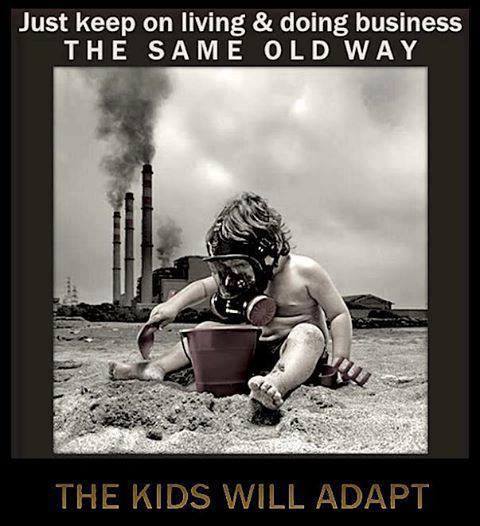
Buyout packages allegedly silence Albertans struck with oil and gas industry-related cancer
Natural Gas Operations from a Public Health Perspective
Video clip by FrackingCanada Fracking Rocky View County: A company trying to burn off chemicals and waste gases after a frac job.
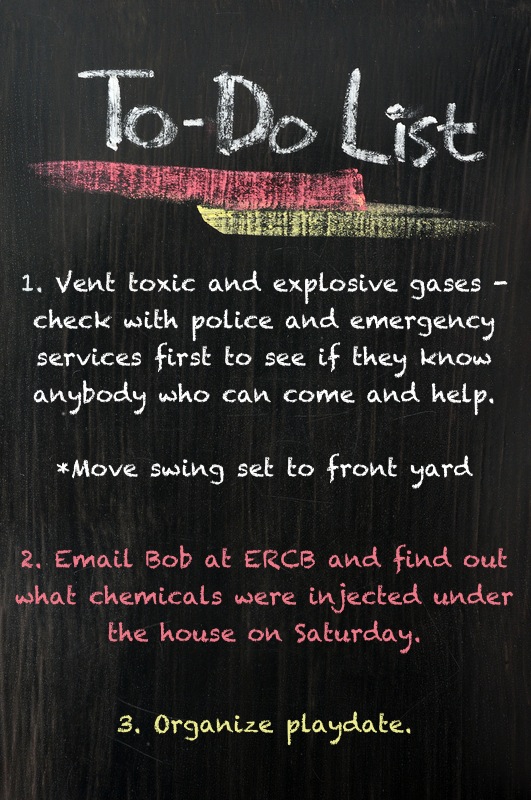
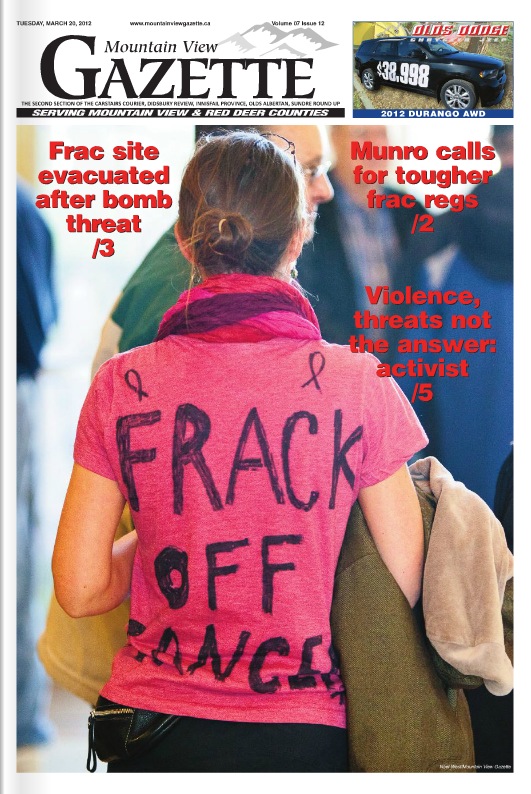 Kimberly Mildenstein attends frac presentation at Mountain View County, by Councilor Paddy Munro, March 2012. Mr. Munro called fracing “crimes against humanity”
Kimberly Mildenstein attends frac presentation at Mountain View County, by Councilor Paddy Munro, March 2012. Mr. Munro called fracing “crimes against humanity”
Source of snaps: FrackingCanada No Duty of Care
Slide from presentation by Larysa Dyrszka MD, September 2013 – Click on slide for more.
March 12, 2014: Cochrane Interpipeline Gas Plant NW of Calgary
Above 2012 Email from Alberta Health Services to Jessica Ernst, in response to her questions and concerns about peer-reviewed studies in the US indicating significant negative health impacts from oil and gas drilling and hydraulic fracturing.

